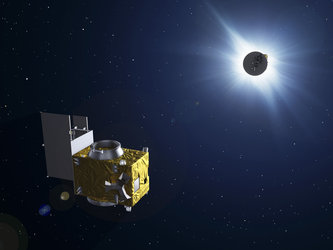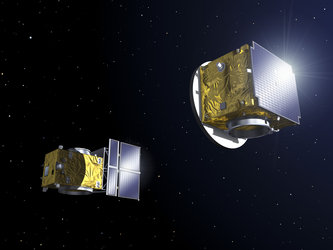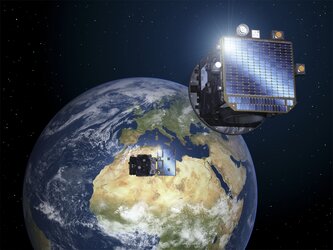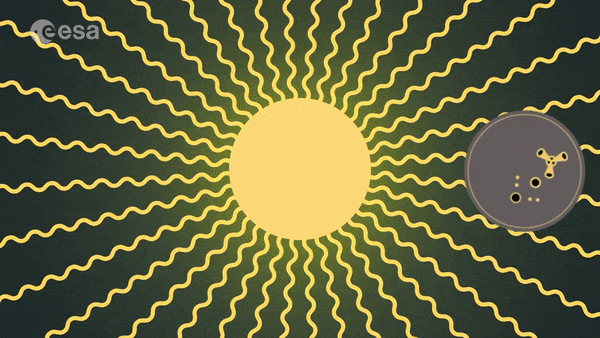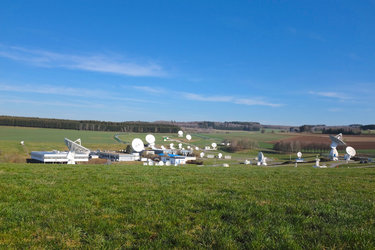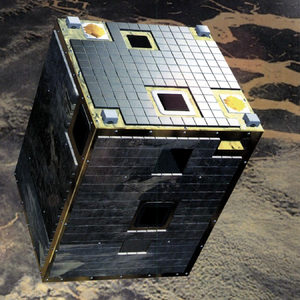Proba-3 operations
Proba-3 is ESA’s formation flying technology demonstrator mission. A pair of satellites will form and maintain the equivalent of a ‘large rigid structure’ in space for up to six hours at a time. In doing so, they will demonstrate high-precision formation flying technologies, generate predictable, prolonged solar eclipses for scientific study of the Sun’s corona, and conduct close-proximity and rendezvous experiments with future applications in Earth orbit and beyond.
Mission operations overview
ESA’s Project for On-board Autonomy (Proba) missions are operated from the ESEC SmallSat Operations Centre at the agency’s European Space Security and Education Centre (ESEC) in Redu, Belgium.
The Proba missions have a very small flight control team. Unlike the missions controlled from ESA’s European Space Operations Centre (ESOC) in Germany, the Proba satellites are controlled via an automated Mission Control System and a dedicated tracking terminal located at ESEC. The operations team at ESEC has overseen the operations of Proba-1 for over 20 years and is now responsible for Proba-1, -2, -V, and -3.
The Proba mission operations are automated to a higher degree than most other ESA missions. Autonomous navigation is enabled by GNSS position determination and onboard orbit propagation. Routine navigation is performed on board the satellites. The ground segment is largely automated, allowing for unsupervised passes with automatic uplink of telecommands, reception and processing of telemetry, the extraction and distribution of payload products from Redu via an internet server, and even spacecraft recovery from certain well-understood anomalies.

Proba-3 is much more complex than previous Proba missions. Traditional Proba missions are ‘SmallSats’ with masses of 100 to 150 kg. They operate in reasonably simple Low-Earth Orbits with multiple, consistent 8—10-minute ground station passes per day. Proba-3 is two satellites, rather than one: the Coronagraph satellite has a mass of 340 kg, the Occulter has a mass of 200 kg, and they will operate in a highly elliptical orbit.
Spacecraft safety is also much more complex for Proba-3. The possibility of losing control of either spacecraft during formation flying represents a permanent collision risk. Additionally, if either of the satellites receives a warning of a potential collision with another satellite or piece of space debris, both must be carefully manoeuvred to reduce the collision risk while maintaining a safe separation from each other.
Automated onboard systems will keep the satellite safe most of the time, but when they are unable to guarantee a certain low level of risk, human operators will assume responsibility. Such a scenario could occur outside of a communications window, so Proba-3 also features the most complex and critical ‘safe mode’ of any Proba mission, which is designed to keep both spacecraft alive in an emergency until human operators can step in.
Proba-3’s routine operations will last approximately two years. Both satellites will need to burn fuel to conduct manoeuvres every single orbit. They will also be constantly manoeuvring during periods of formation flying in order to maintain mm-level relative positioning precision.
Precision formation flying

By performing high-precision, millimetre-scale formation flying, the dual Proba-3 satellites will accomplish what was previously a ‘mission impossible’: casting a precisely held shadow from one spacecraft to the other to block out the fiery face of the Sun and allow scientists to observe its surrounding atmosphere for a prolonged period of time.
During formation flying, the spacecraft will be as close as 150 metres apart with mm-precision. While not maintaining their precision formation they may be separated by up to a few hundred metres.
The formation flying will be maintained for up to six hours at a time, allowing scientists hours of uninterrupted coronal observations. For comparison, a typical total solar eclipse viewed from Earth lasts just 10 minutes.
Towards the end of the mission, the Proba-3 team will push precision and close formation flying to the limit. Proba-3 will determine how close two spacecraft can safely maintain such a formation.

Predicting the relative motions of two spacecraft to such high precision is a complex computational task which usually requires powerful processors. This was a challenge to implement within the relatively modest processing power capability of Proba-3's onboard computers. ESA and the industrial teams developed an onboard control algorithm based on innovative simplifications of the relative orbit model which allows it to run on the onboard computers.
High-precision formation flying has many applications. Future in-orbit servicing or satellite refuelling missions will need to safely approach existing satellites. Other types of mission, such as the NASA/ESA Mars Sample Return, require a precise rendezvous. During the Mars Sample Return, two spacecraft will meet in Mars orbit to exchange samples from the martian surface without navigational support from GNSS systems available at Earth and with a long communication delay for any commanding from Earth. This rendezvous will need to be carried out by highly accurate and autonomous onboard navigation systems.
Orbit
Proba-3 will operate in a highly elliptical orbit more similar to orbiting observatories such as XMM Newton or Integral than to the other Proba missions. In order to accommodate the mission’s scientific and technology demonstration goals, its orbit will take it as far as 60 000 km from Earth’s surface and as close as 600 km.
As a result, Proba-3 has much more complex ground station communication pass visibility sequence than the other Proba missions: some will be as long as 12 hour, others as short as 30 minutes. The ESEC team has developed a new ground station planning tool capable of handling both extremes that determines the best period of visibility given the mission’s operational and station constraints. The passes will be scheduled in advance and executed by autonomous systems onboard the satellites and at the ESEC SmallSat Operations Centre.
Proba-3 will complete one orbit every 19.7 hours. Each orbit will have a specific focus such as coronagraph science or formation flying technology demonstration. The mission will enable scientists to observe the solar corona much more frequently than natural total solar eclipses. Over the mission’s two-year nominal lifetime, it will complete more than 800 orbits.
ESEC SmallSat Operations Centre

Proba-3 shares its control room in Redu with the other Proba missions. Its onboard computer, basic software, industrial organisation, operations team and assembly, integration and testing approach all build on the heritage of the Proba series.
The mission’s ground segment software was developed by Spacebel, based on satellite control software originally developed at ESOC. It integrates the Flight Dynamics System developed for Proba-3 by GMV. The automated system allows satellite passes without an operator. The small operations team is in charge of the payload and platform operations, planning, monitoring, reporting and stepping in in event of a contingency.
Flight dynamics experts at ESOC will be involved in the validation of the output of Proba-3’s software during the mission’s Commissioning Phase. ESOC’s space debris office, network operations and mission operations infrastructure facilities will also support the Proba-3 mission.
Ground stations
The ground station antennas supporting communications with Proba-3 are located at Villafranca and Maspalomas in Spain, operated by the Spanish National Institute of Aerospace Technology (INTA), and in Western Australia and Santiago, Chile, operated by the Swedish Space Corporation (SSC).
The interface between the Proba-3 mission operations centre in Redu and the ground stations is provided by ESOC in Germany. Scientific data downloaded at the mission’s ground stations are automatically sent from the ESEC SmallSat Operations centre to the Proba-3 science operations centre, located at the Royal Observatory of Belgium (ROB) in Brussels, through an internet link.
Operations timeline

Proba-3 is scheduled to launch from India in 2024 on a PSLV launcher. The launcher will deliver the two spacecraft, still attached to one another, directly into their operational orbit.
The Launch and Early Orbit Phase will last up to 48 hours as the ground teams confirm launch survival and assess the spacecraft’s health and basic services, power and communications, and attitude control system.
The Commissioning Phase will last for up to 18 weeks, during which the teams will check-out the two satellites’ subsystems and assess the functionality of the payloads such as the coronagraph.
Once the team is satisfied that everything is functioning correctly, the two spacecraft will then separate. The separation represents a milestone as significant as the launch itself. Separation is not autonomous and will be controlled by the ESA and industry operations team at ESEC.
The two spacecraft will then enter a ‘safe orbit’ as the team validates the intersatellite separation and safety protocols. The spacecraft will be brought closer together and the orbit ‘tightened’ before they are then safely moved apart again. Once this has been successfully demonstrated, the mission will transition from its safe orbit to formation flying.
Commissioning of the mission’s scientific instruments will follow, before the two spacecraft enter routine, automated operations.















 Germany
Germany
 Austria
Austria
 Belgium
Belgium
 Denmark
Denmark
 Spain
Spain
 Estonia
Estonia
 Finland
Finland
 France
France
 Greece
Greece
 Hungary
Hungary
 Ireland
Ireland
 Italy
Italy
 Luxembourg
Luxembourg
 Norway
Norway
 The Netherlands
The Netherlands
 Poland
Poland
 Portugal
Portugal
 Czechia
Czechia
 Romania
Romania
 United Kingdom
United Kingdom
 Slovenia
Slovenia
 Sweden
Sweden
 Switzerland
Switzerland



























